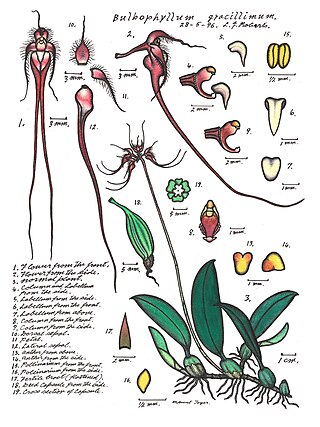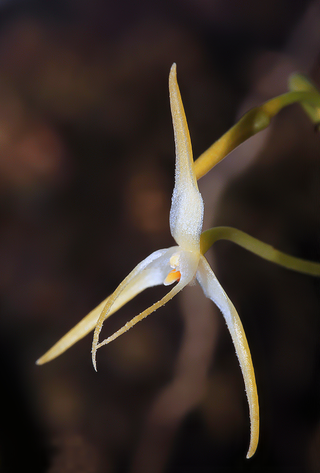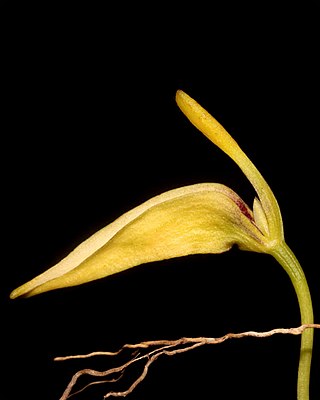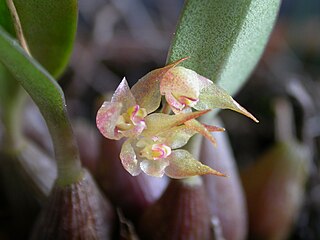
Orchids are plants that belong to the family Orchidaceae, a diverse and widespread group of flowering plants with blooms that are often colourful and fragrant. Orchids are cosmopolitan plants that are found in almost every habitat on Earth except glaciers. The world's richest diversity of orchid genera and species is found in the tropics.

Bulbophyllum is a genus of mostly epiphytic and lithophytic orchids in the family Orchidaceae. It is the largest genus in the orchid family and one of the largest genera of flowering plants with more than 2,000 species, exceeded in number only by Astragalus. These orchids are found in diverse habitats throughout most of the warmer parts of the world including Africa, southern Asia, Latin America, the West Indies, and various islands in the Indian and Pacific Oceans. Orchids in this genus have thread-like or fibrous roots that creep over the surface of trees or rocks or hang from branches. The stem is divided into a rhizome and a pseudobulb, a feature that distinguished this genus from Dendrobium. There is usually only a single leaf at the top of the pseudobulb and from one to many flowers are arranged along an unbranched flowering stem that arises from the base of the pseudobulb. Several attempts have been made to separate Bulbophyllum into smaller genera, but most have not been accepted by the World Checklist of Selected Plant Families.

Bulbophyllum biflorum is a species of orchid. This species was found in Java, Sumatra, Bali, Borneo, the Philippines, and the Thai and Malaysian peninsula. The flower size is 7.5 cm long.
Bulbophyllum abbreviatum is a species of orchid in the genus Bulbophyllum discovered in Madagascar and originally described by German botanist Rudolf Schlechter, from material collected by French botanist H. Perrier de la Bâthie in February 1912, which is now kept in the Muséum National d'Histoire Naturelle in Paris.

Bulbophyllum amplebracteatum is a species of orchid in the genus Bulbophyllum.

Bulbophyllum apodum is a species of orchid in the genus Bulbophyllum. It bears a 12–14 cm inflorescence with around 40 small fragrant white flowers on it. It is native to Sikkim, Borneo, China, Malaysia, Thailand, the Philippines, Vanuatu, and Vietnam.
Bulbophyllum betchei is a species of orchid in the genus Bulbophyllum.
Bulbophyllum brienianum is a species of orchid in the genus Bulbophyllum.

Bulbophyllum gracillimum, commonly known as the wispy umbrella orchid, is a species of epiphytic orchid. It has a creeping rhizome, widely spaced, olive green pseudobulbs, each with a single thick, leathery, fleshy leaf and between six and ten purplish red flowers spreading in a semicircular umbel. The flowers have distinctive long, thread-like tails on the lateral sepals. It has a wide distribution and is found in New Guinea, New Caledonia, Indonesia, Malaysia and part of tropical North Queensland.

Bulbophyllum laxiflorum is a species of orchid in the genus Bulbophyllum.

Bulbophyllum moniliforme is a species of orchid in the genus Bulbophyllum. It is indigenous to the Assam region in eastern India.

Bulbophyllum odoratum is a species of orchid in the genus Bulbophyllum.

Bulbophyllum ovalifolium is a species of orchid in the genus Bulbophyllum.

Bulbophyllum phalaenopsis is a species of orchid in the genus Bulbophyllum.

Bulbophyllum restrepiaa is a species of orchid in the genus Bulbophyllum.

Bulbophyllum scabratum, butterfly egg Bulbophyllum, or Rough Bulb-Leaf Orchid is a species of orchid in the genus Bulbophyllum in section Eublepharon.
Bulbophyllum unguiculatum is a species of orchid in the genus Bulbophyllum. It is commonly known as the clawed bulbophyllum. It is found in Sumatra, Java, Borneo and Sulawesi in lower montane forests.
Bulbophyllum nocturnum is a species of epiphytic orchid that grows in New Britain. It was described in 2011, and is the first species of orchid known to consistently flower during the night, and close its flowers during the day.

Dendrobieae is a tribe in the subfamily Epidendroideae, in the family Orchidaceae. The Dendrobieae are mostly tropical, epiphytic orchids which contain pseudobulbs.
An attractant is any chemical that attracts an organism, e.g. i) synthetic lures; ii) aggregation and sex pheromones ; and iii) synomone













